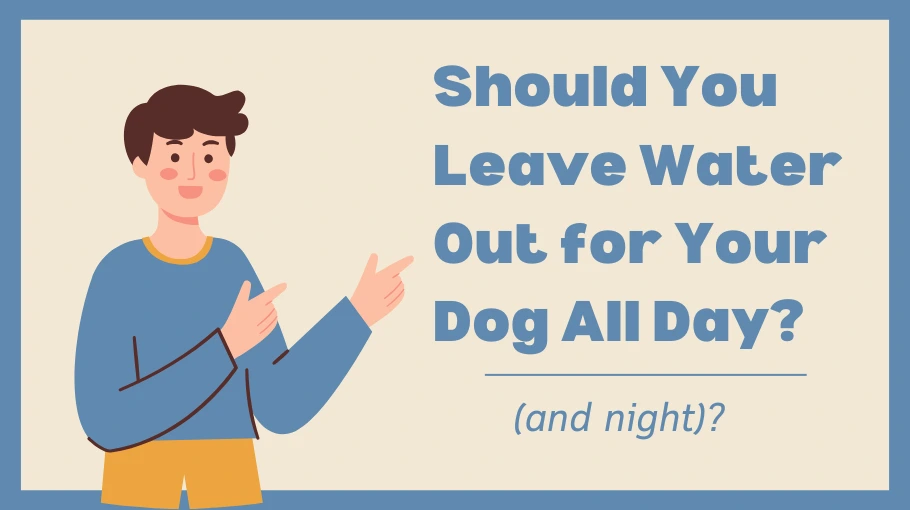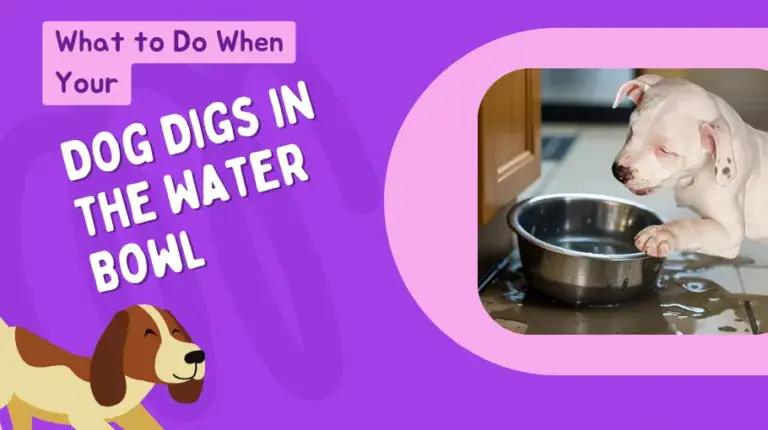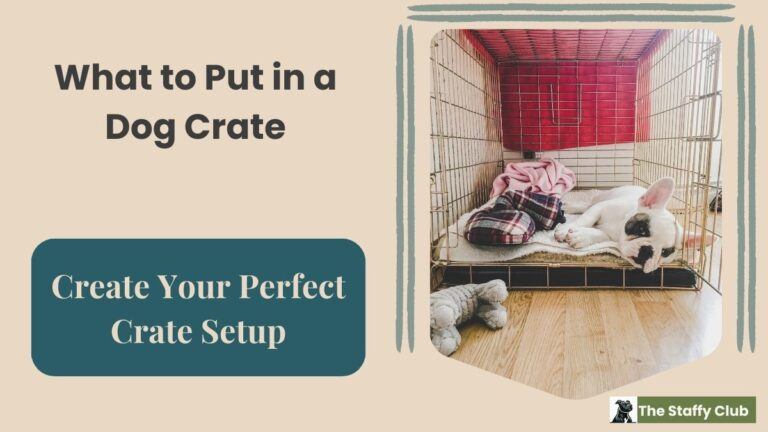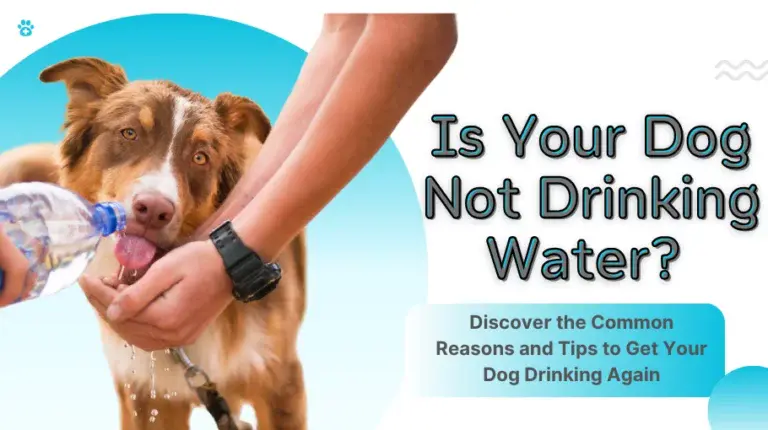Should You Leave Water Out for Your Dog All Day (and Night)?

Ever stopped mid-pour and wondered, “Should you leave water out for your dog all day?” Been there. Right after a long scrubbing session to get rid of algae from the corner of a stainless steel bowl.
Following that episode, I delved deeper into the issue and discovered that many dog owners are unsure whether unfettered access to water is a good idea or a health risk. Some worry their dog might overdrink, others are in the thick of puppy potty training and wondering if constant access to water is making things harder.
The truth? Like many dog care questions, the answer isn’t a flat yes or no — it depends on your dog’s age, routine, health, and where the water bowl is kept.
Now, there are times when leaving water out makes sense, and other times, it may not be the wisest thing to do.
Take a deep dive into the world of dog hydration:
Should Dogs Have Access to Water All Day?
For most adult dogs, yes — access to fresh water throughout the day is essential. Hydration supports healthy digestion, joint lubrication, temperature regulation, and kidney function. Denying that access without a medical reason can do more harm than good.
Most vet resources I’ve read recommend that dogs drink approximately 50–60 ml of water per kg of body weight per day. That means a 20 kg Staffy might need 1 to 1.2 litres daily — more if it’s hot out, they’re active, or eating dry kibble.
So, should you always leave the bowl out?
In most cases, yes — but with a few caveats:
- Make sure the bowl is clean and the water is changed at least once a day (more often in summer).
- Place it away from direct sunlight to avoid bacteria or algae growth.
- Avoid using lightweight plastic bowls that tip or slide easily — a stable ceramic or stainless-steel option is better for 24/7 access.
- I say about those types of bowls because they’re easier to keep clean. A clean dog water bowl is more important than having access to dirty water… it’s not healthy or appealing!
Monitoring Water Intake in Dogs With Medical Conditions
Dogs with certain medical conditions, such as kidney disease or heart issues, may need their water intake closely monitored. This is emphasised by both VCA Animal Hospitals and Tufts Foster Hospital for Small Animals, which recommend that any adjustments to water intake should always be made under the guidance of your veterinarian, as they know your dog’s unique health needs and what’s best for its long-term wellbeing.
Key Point:
If your dog has a medical condition, always consult your vet about how much water your dog should drink, and follow their instructions for monitoring and managing water intake.
When Not to Leave Water Out: Puppies, House Training & Bedtime
While most adult dogs benefit from free access to water, there are a few situations where you might need to limit when or where water is available — temporarily and with purpose.
Puppies in House Training
This is where the water bowl becomes part of a training strategy. Leaving water out for a puppy all day and night can make it harder to predict their toilet needs — especially overnight.
Here’s what I’ve read some trainers recommend:
- Leave water out during the day, but pick it up 2–3 hours before bedtime to reduce accidents.
- After your puppy has mastered potty training, you can gradually offer more freedom with water access again.
- Use water breaks as structured opportunities, especially after meals, naps, or playtime — times when they’re likely to need the loo soon after.
Quick Tip: If you’re removing the water bowl for practical reasons — like stopping spills in the crate or managing nighttime accidents — just make sure it doesn’t feel like a consequence to your dog. You’re not punishing them, but dogs can sometimes associate the absence of water (or anything – even toys) with something they did “wrong.”
To avoid this, stick to a consistent routine, offer water before and after crate time, and ensure they’re drinking enough during the day — especially in hot weather or after play.
Now, if spills are the issue, consider a clip-on crate bowl or no-spill design that keeps water secure without leaving your dog thirsty overnight.
At Night: Should You Leave Water Out?
There’s no one-size-fits-all rule here. It depends on your dog’s:
- Age
- Bladder control
- Health
- And sleeping arrangement (e.g., crate vs open house)
Here’s a simple guide:
- Puppies → Pick up the water before bed.
- Healthy adult dogs → It’s usually fine to offer access unless it leads to disrupted sleep.
- Senior dogs or those with incontinence → You may want to restrict access after a certain time, but speak to your vet first when there’s a medical issue at play.
- Crated dogs overnight → Some owners prefer not to leave a bowl in the crate to avoid spills. In that case, make sure the dog gets water before and right after crating.
If your dog wakes up frequently at night needing water, consider whether the room is too warm, the food is too salty, or their bowl isn’t full during the day.
(You might also want to check out this post on why your dog avoids their crate water bowl — it might reveal more than you expect.)
Can You Limit a Dog’s Water Intake Safely?
This is one of those questions that walks a fine line. Yes, there are situations where limiting a dog’s water makes sense — but it has to be done carefully and for the right reasons.
Situations Where Limiting Water Might Be Recommended
- Medical conditions like kidney disease, heart issues, or Addison’s disease
- Before or after surgery, as advised by a vet
- Medication timing, if fluid intake affects absorption or side effects
In these cases, your vet will give you a specific hydration plan. Never reduce water access unless a medical professional recommends it.
Key Point:
If your dog is drinking more water than usual, there is a condition known as polydipsia (excessive thirst)—often paired with polyuria (increased urination), together called PU/PD. These symptoms can signal underlying medical issues and should always be discussed with your veterinarian for proper diagnosis and care.
For more information about the causes and management of excessive thirst in dogs, see these resources:
- Davies Veterinary Specialists (Linnaeus Veterinary): Polydipsia in Dogs and Cats (increased drinking) Fact Sheet
- PetMD: Why Is My Dog Drinking a Lot of Water?
- Vet Collection: Polyuria-Polydipsia (PUPD) In Pets
When It’s Not Safe to Withhold Water
Outside of short-term training routines (like pre-bedtime for puppies), restricting water for too long can quickly become dangerous. Dog’s not drinking water can lead to them quickly becoming dehydrated within hours, especially:
- In warm or poorly ventilated environments
- After physical activity
- When eating only dry kibble diets
Even crate-trained dogs need access to water at regular intervals. If they’re going to be confined for more than a couple of hours, make sure they’ve had a drink beforehand — or use a secure bowl or crate bottle to keep water available without spills.
Still unsure what’s safe? A good general rule: if your dog will be without water for more than 3–4 hours, especially in warm weather, they should either have access or be offered water before and after that period.
If your dog seems to drink a lot all at once, it’s not necessarily a sign of a problem — they may just be making up for lost hydration time. But if it happens often, you might want to evaluate whether their current routine is unintentionally limiting access.
How Often Should You Fill the Water Bowl?
You’d be surprised how many dog owners think one fill-up a day is enough—but that’s rarely the case. Dogs don’t just need access to water; they need it to be fresh, clean, and appealing enough to actually drink.
So, how often should you top it up?
At least once or twice a day, even if the bowl isn’t empty yet. Consider filling it even more often if:
- It’s hot out
- Your dog drools in the bowl (hello, Staffies!)
- They eat mainly dry food
- There’s dust, food crumbs, or grass in it
- You’re using a plastic bowl, which can develop a slimy biofilm faster
Many dogs turn their noses up at stale water. If your dog seems uninterested in drinking, the issue might not be how much water they have—but how clean or cool it is.
Why Cleanliness Matters
Keeping your dog’s water bowl clean is just as important as keeping it full. Dirty bowls can harbour bacteria like Salmonella, E. coli, and even MRSA—putting your dog (and you) at risk of illness. Over time, a slimy biofilm builds up, creating a breeding ground for harmful microorganisms.
For more tips on why and how to keep your dog’s water bowl clean, check out our detailed guide:
Tip: Time Your Refills with Their Routine
Try syncing bowl checks with daily events: first thing in the morning, after walks, before bed. Not only does it keep the water fresh — it gives you a consistent habit to spot changes in how much your dog is drinking (which can be an early warning sign of health issues).
Choosing the Right Bowl to Keep Water Clean and Safe
You can be doing everything else right — fresh water, good timing, steady routine — but if the bowl itself is letting you down, your dog might still avoid drinking.
Here’s some insights into what matters most when picking a bowl that actually helps your dog stay hydrated.
Best Materials for Everyday Use
- Stainless Steel: Hygienic, easy to clean, and doesn’t hold odours. It’s the top choice for most dog professionals (including in dog socialisation classes where they’re used as communal bowls) and by dog owners, as it’s the type least likely to develop bacteria or biofilm.
- Ceramic (lead-free, glazed): Stylish and heavy enough not to tip. Just make sure it’s labelled food-safe.
- Plastic: The budget option—but often the worst long-term. Plastic scratches easily, which creates perfect grooves for bacteria and slimy buildup to form. In fact, for dogs that have developed chin acne, switching to stainless steel or ceramic is widely recommended by veterinarians.
Curious what can grow in a dog bowl? This article on green algae in water bowls covers how quickly stagnant water becomes a breeding ground for bacteria, especially in summer.
Bowl Shape & Features Matter Too
- Clip-on crate bowls or no-spill designs are great for travel or nighttime crate setups.
- Elevated bowls can help larger breeds or dogs with joint issues drink more comfortably.
- Want more on finding the right fit? Check out our full guide: The Best Water Bowls for Dogs: Healthier Hydration
- Or head to our size-focused breakdown: Dog Water Bowls for Large Dogs: Your Ultimate Guide
Cleaning Routine is Just as Important
No matter what kind of bowl you use, daily rinsing and weekly deep cleaning should be part of the routine.
Final Thoughts: Should You Leave Water Out for Your Dog All Day (and Night)?
In most cases, yes — you absolutely should leave water out for your dog throughout the day. Dogs need regular access to fresh, clean water to stay healthy, especially in warmer months or if they’re active. But that doesn’t mean the same bowl of water should sit out untouched from morning to night.
Here’s what to keep in mind:
- Freshness matters more than just availability. Even if the bowl isn’t empty, refill it at least once or twice daily — more if it’s hot, your dog drools, or debris keeps getting in. I find it helpful to have a bowl where I can see them. If the dog goes to the bowl to get a drink then doesn’t drink, there’s likely a reason for it. I don’t go to the tap for a glass of water, then change my mind. Something would have to happen like turning the tap on and seeing brown water come out like there’s work being done on the mains.
- Material makes a difference. Stainless steel or ceramic bowls help water stay fresher longer, while plastic can develop micro-scratches that harbour bacteria and biofilm — not ideal if you’re trying to “set and forget” a bowl all day.
- Some temporary limits are okay — like removing the bowl from a crate overnight to prevent spills, or picking it up an hour or two before bedtime while house training a puppy. Just be sure your dog is well hydrated during the day and gets a drink before and after any planned dry spells.
- If you’ll be away for more than 3–4 hours and your dog is confined, a no-spill bowl or clip-on crate dish can give them safe access to water without mess.
The bottom line? Water should be available throughout the day — but it needs to be something your dog actually wants to drink. That means clean, cool, and in a bowl that doesn’t make them turn up their nose!






